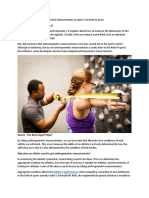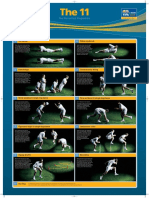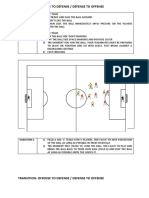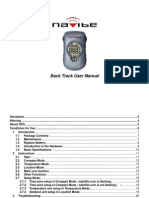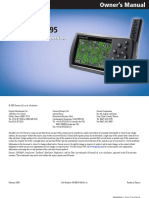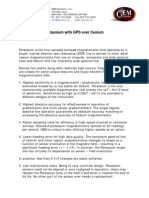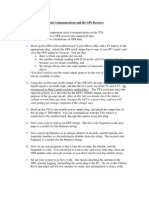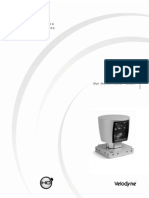OptimEye G5 User Guide
OptimEye G5 User Guide
Uploaded by
Nicholas AndryievichOriginal Description:
Original Title
Copyright
Available Formats
Share this document
Did you find this document useful?
Is this content inappropriate?
Copyright:
Available Formats
OptimEye G5 User Guide
OptimEye G5 User Guide
Uploaded by
Nicholas AndryievichCopyright:
Available Formats
THE WORLD’S FIRST GOALKEEPER MONITOR
Goalkeeper training is often isolated and highly specific to position, with performance monitoring limited to heart rate.
Accurately quantity dives (direction and intensity), jumps, accelerations, decelerations, changes of direction, repeat high intensity efforts and metabolic power -
allowing for differentiation of physiological demands/loading that may not be determined by traditional velocity measures.
Find your goalkeepers’ fingerprints.
COMFORTABLE ANTENNA
Taking up two thirds of the device, the GNSS device
Engineered specifically for elite athletes, with
accesses both GPS and GLONASS satellites.
over a decade of design experience.
ATHLETE ID STRIP LED LIGHTS
Designed to write athlete’s name/playing number Shows: Battery remaining, GPS lock, USB connection,
with permanent marker for easy identification. heart rate in range, SmartBall connection.
ULTRASONIC WELDED CASE BUTTON
No screws, reducing stress points on casing. Turns device on and off. Cannot be turned
Device is splash proof but not waterproof. off when athlete is laying on back.
SET UP TECHNOLOGY
1. Make sure OptimEye G5 has enough battery. Each device contains three sensor components:
Devices typically take 2-3 hours for a full charge, 1. Accelerometer: Measures the rate of acceleration of the player
and the battery will last up to six hours. 2. Gyroscope: Measures the angular movement of the player
2. The top LED light will be green when connected in the charge case if the 3. Magnetometer: Measures the direction of the movement
device is charged.
3. Turn on OptimEye G5 by pressing the button. The device will vibrate and OptimEye G5 can be used indoors using these sensors to generate data,
the top light will flash green. however velocity data (e.g. total distance, high speed distance) is not possible
4. Put OptimEye G5 inside compression top with pouch in the normal as the device needs outdoor satellite access for these parameters.
operation (worn on T1 section of the spine with OptimEye G5 logo facing
away from the athlete).
GNSS engine Fifth-generation 10Hz GNSS engine
5. Ensure the the device is tight inside the pouch to reduce the noise within
Accelerometers 3D, 2-16g, up to 1000Hz
the data. Gyroscopes 3D, 2000 degrees/second, up to 1000Hz
6. Put on the heart rate belt, making sure it is positioned under the ribcage Magnetometers 3D, up to 1000Hz
Heart rate Polar compatible pickup (Polar T-31C or Polar Team 2)
and is tight around the body. Also recommended to wet the belt to improve
Memory 2gb internal flash (60 hours)
signal connection with GPS device.
Battery Six hours, lithium ion rechargeable
7. You can see if the heart rate belt is connected by the middle light on Size 96mm x 52mm x 14mm
OptimEye G5 flashing red. Weight 67g
Harness Antibacterial moisture management fabric
8. Once outside, OptimEye G5 will take a few minutes to connect to the
Environmental protection Water resistant
satellites. If a green light is flashing quickly then it is not connected; if the Indoor use Heart rate and inertial sensor data
green light is flashing slowly then it is connected. Real time data Wireless data transmission 250m
DIVE EFFORTS DIVE INTENSITY DIVE RETURN
Number of dives performed to The impact force of each dive effort when Time from start of dive to back in upright
either the left or right side. the player hits the ground. position following dive effort.
DISTANCE HIGH SPEED DISTANCE PLAYERLOAD
Fundamental volume metric for Measures distance covered above certain All-encompassing measure of physical
understanding basic load levels. high velocity threshold set by the user. load placed on athlete with one figure.
ACCELERATIONS DECELERATIONS % HEART RATE MAX
Important performance metric Ultimate measurement of the stress Time spent above a specific threshold of
differentiating athlete speed explosion. placed on the body after a session. maximal heart rate determined by the user.
You might also like
- FYP Interim ReportDocument22 pagesFYP Interim ReportNitheeshNoch keine Bewertungen
- Nokia Help2 PDFDocument148 pagesNokia Help2 PDFAzzu Kh50% (2)
- PL2 2022-23 Handbook Update 09.22Document29 pagesPL2 2022-23 Handbook Update 09.22Soul Central Magazine ExtraNoch keine Bewertungen
- Brochure - Catapult VectorDocument24 pagesBrochure - Catapult VectorNicholas AndryievichNoch keine Bewertungen
- Business Analytics PresentationDocument11 pagesBusiness Analytics PresentationDiksha LathNoch keine Bewertungen
- Anthropometric Measurements in Sports We Need To KnowDocument9 pagesAnthropometric Measurements in Sports We Need To KnowBekama Abdii Koo TesfayeNoch keine Bewertungen
- 6 Periodization of SpeedDocument11 pages6 Periodization of SpeedTyler WriceNoch keine Bewertungen
- C Sciberras - Consolidation of Goalkeeper Education in MaltaDocument42 pagesC Sciberras - Consolidation of Goalkeeper Education in MaltaKushtrim AbdullahiNoch keine Bewertungen
- EchellesDocument51 pagesEchellesEric BretonNoch keine Bewertungen
- FFA Goalkeeping Key FactorsDocument18 pagesFFA Goalkeeping Key FactorsSana NasirNoch keine Bewertungen
- The Prevention Programme: The Bench Sideways BenchDocument1 pageThe Prevention Programme: The Bench Sideways BenchkarimNoch keine Bewertungen
- Lesson Plan: Activity Name Description Diagram Purpose/Coaching PointsDocument4 pagesLesson Plan: Activity Name Description Diagram Purpose/Coaching PointspklNoch keine Bewertungen
- Colorado EDGE GK Curiculum Aug 2012Document20 pagesColorado EDGE GK Curiculum Aug 2012Budi HandokoNoch keine Bewertungen
- The Modern Goalkeeper: by Neil Cooper CAPA Trainer / CoachDocument54 pagesThe Modern Goalkeeper: by Neil Cooper CAPA Trainer / CoachCésar PáezNoch keine Bewertungen
- 7 V 7 + 3 Positional PossessionDocument1 page7 V 7 + 3 Positional PossessionHung HuGoNoch keine Bewertungen
- Smarter Footballer Methodology BookDocument149 pagesSmarter Footballer Methodology BookAbd Rahman BenNoch keine Bewertungen
- 2V2 Defend Your GoalDocument7 pages2V2 Defend Your GoalNAYIM OZNAIMNoch keine Bewertungen
- Triphasic TrainingDocument353 pagesTriphasic Traininggsrjs9hh2pNoch keine Bewertungen
- GPS Technical Training Program Curriculum 2016 - U11 U12Document28 pagesGPS Technical Training Program Curriculum 2016 - U11 U12jun chenNoch keine Bewertungen
- 1 GK Building BlocksDocument16 pages1 GK Building Blocksapi-317041644Noch keine Bewertungen
- Coaches Circle Issue 6 - May 2021Document24 pagesCoaches Circle Issue 6 - May 2021เซบาสเตียน ไลฟ์ลีดเดอร์Noch keine Bewertungen
- Embedded Insurance by Rashmika WijesingheDocument17 pagesEmbedded Insurance by Rashmika Wijesinghearc chanukaNoch keine Bewertungen
- UEFABPHASESOFPLAYDocument25 pagesUEFABPHASESOFPLAYDanilo Andres Silva EsparzaNoch keine Bewertungen
- Grassroots Sessions Toolkit FINALDocument34 pagesGrassroots Sessions Toolkit FINALlaureineNoch keine Bewertungen
- MF Session 7 - Active Start - Ball MasteryDocument8 pagesMF Session 7 - Active Start - Ball MasteryivanazazelNoch keine Bewertungen
- APPENDIX I - Tactical Styles: SI Games FM-Britain - Co.uk Thinktank@fm-Britain - Co.ukDocument24 pagesAPPENDIX I - Tactical Styles: SI Games FM-Britain - Co.uk Thinktank@fm-Britain - Co.ukjaysimpNoch keine Bewertungen
- Coaches Handbook: GrassrootsDocument20 pagesCoaches Handbook: GrassrootskarimNoch keine Bewertungen
- Planning and Budgeting Ver 2Document23 pagesPlanning and Budgeting Ver 2BrianNoch keine Bewertungen
- Club Age Group Coach Session Title Date Start Time Duration No. of PlayersDocument2 pagesClub Age Group Coach Session Title Date Start Time Duration No. of PlayersNestor OrozcoNoch keine Bewertungen
- Robotic GoalkeeperDocument25 pagesRobotic Goalkeeperstudsudzzz100% (3)
- TTC Curriculum - U13 U14Document6 pagesTTC Curriculum - U13 U14jun chenNoch keine Bewertungen
- Training The Tactical System 11vs11 PDFDocument3 pagesTraining The Tactical System 11vs11 PDFAkram Hamici100% (1)
- Individual Defending 1: Practice OrganisationDocument1 pageIndividual Defending 1: Practice OrganisationChris HoltNoch keine Bewertungen
- TPT ProgramDocument17 pagesTPT Programjun chenNoch keine Bewertungen
- 60 Training Games Beale 2017 PDF FreeDocument68 pages60 Training Games Beale 2017 PDF FreeCaptain-Ramadan Al-zubidyNoch keine Bewertungen
- 9.transition Offense To Defense, Defense To OffenseDocument2 pages9.transition Offense To Defense, Defense To OffenseNurazin RizalNoch keine Bewertungen
- Bielsa Training1Document166 pagesBielsa Training1One of the Moroccan peopleNoch keine Bewertungen
- Drill 1 Drill 2 Drill 3: Rules / Objectives: Rules / Objectives: Rules / ObjectivesDocument13 pagesDrill 1 Drill 2 Drill 3: Rules / Objectives: Rules / Objectives: Rules / ObjectivesibikaNoch keine Bewertungen
- Womens Positional ResponsibilitiesDocument10 pagesWomens Positional ResponsibilitiesМихаил ПетрукNoch keine Bewertungen
- Sportsmetrics Jump TrainingDocument1 pageSportsmetrics Jump TrainingSean MceachernNoch keine Bewertungen
- Pass & Communicate CircuitDocument1 pagePass & Communicate CircuitGiovanni AlemaoNoch keine Bewertungen
- Games Analysis Outdoor Team Sports by Using GPS SystemDocument35 pagesGames Analysis Outdoor Team Sports by Using GPS SystemAmin CherbitiNoch keine Bewertungen
- Attacking Play in A Small-Sided GameDocument1 pageAttacking Play in A Small-Sided GameChris HoltNoch keine Bewertungen
- Defending and Recovering PositionDocument1 pageDefending and Recovering PositionChris HoltNoch keine Bewertungen
- U13-u18-Intermed - Advanced Coach ManualDocument41 pagesU13-u18-Intermed - Advanced Coach Manualjun chenNoch keine Bewertungen
- B Licence GK ModuleDocument47 pagesB Licence GK Modulekarlhansharbers85100% (1)
- Ferencváros 2-1 Crvena ZvezdaDocument25 pagesFerencváros 2-1 Crvena ZvezdaÜllői SzázhuszonkilencNoch keine Bewertungen
- 011 Fifa Cyp Defense TaDocument16 pages011 Fifa Cyp Defense TacyprusfutsalNoch keine Bewertungen
- Defending PracticesDocument8 pagesDefending PracticesJohn GildingNoch keine Bewertungen
- UK SOCCER ACADEMY U13-U19-Rec-Coach-Session-GuideDocument30 pagesUK SOCCER ACADEMY U13-U19-Rec-Coach-Session-Guidebrian.r.vargasNoch keine Bewertungen
- Club Age Group Coach Session Title Date Start Time Duration No. of PlayersDocument2 pagesClub Age Group Coach Session Title Date Start Time Duration No. of PlayersNestor OrozcoNoch keine Bewertungen
- PDF 50 Exercices Physiques en FootballDocument73 pagesPDF 50 Exercices Physiques en FootballSaadi WalidNoch keine Bewertungen
- 6 V 3 Possession With TransitionDocument1 page6 V 3 Possession With TransitionHung HuGoNoch keine Bewertungen
- U9 U10 CurriculumDocument26 pagesU9 U10 CurriculumSam GillNoch keine Bewertungen
- Gareth Southgate Creative Attacking PlayDocument15 pagesGareth Southgate Creative Attacking PlayCaptain-Ramadan Al-zubidyNoch keine Bewertungen
- Training Session 1Document10 pagesTraining Session 1Priyangga EkoNoch keine Bewertungen
- AFC Fitness Coaching Certificate Courses 2021Document2 pagesAFC Fitness Coaching Certificate Courses 2021Mohamad Shalehudin Mohamad NodinNoch keine Bewertungen
- Phase Three Coaching Sessions For AdultsDocument22 pagesPhase Three Coaching Sessions For AdultsNadir Baghdad100% (1)
- فاعلية استخدام برنامج تدريبي مقترح على اللياقة البدنية لدى ناشئي كرة القدم تحت سن 14 سنةDocument240 pagesفاعلية استخدام برنامج تدريبي مقترح على اللياقة البدنية لدى ناشئي كرة القدم تحت سن 14 سنةaseel quria100% (1)
- Session Planner A4 EbookDocument46 pagesSession Planner A4 EbookIsma EscribanoNoch keine Bewertungen
- Navibe Back Track MaunalDocument140 pagesNavibe Back Track Maunalbessel7Noch keine Bewertungen
- WooKong M User Manual en v3.6 130130Document54 pagesWooKong M User Manual en v3.6 130130bobzybob1Noch keine Bewertungen
- 373 IMU PresentationDocument30 pages373 IMU PresentationMaiAnh.VNoch keine Bewertungen
- Test Elementary (Present Simple, Present Continuous, Past Simple, Present Perfect)Document2 pagesTest Elementary (Present Simple, Present Continuous, Past Simple, Present Perfect)Nicholas AndryievichNoch keine Bewertungen
- Past Simple Vs Present Perfect Ex-SDocument1 pagePast Simple Vs Present Perfect Ex-SNicholas AndryievichNoch keine Bewertungen
- OpenField Release Notes 2.2.1Document8 pagesOpenField Release Notes 2.2.1Nicholas AndryievichNoch keine Bewertungen
- Present Perfect Vs Past SimpleDocument1 pagePresent Perfect Vs Past SimpleNicholas AndryievichNoch keine Bewertungen
- 2019 Catapult Vector User GuideDocument21 pages2019 Catapult Vector User GuideNicholas AndryievichNoch keine Bewertungen
- SDR Level 5: Data Collection SoftwareDocument2 pagesSDR Level 5: Data Collection Softwareloganvsa-1Noch keine Bewertungen
- ZED-F9P InterfaceDescription (UBX-18010854)Document245 pagesZED-F9P InterfaceDescription (UBX-18010854)pol delgado martínNoch keine Bewertungen
- GPSDocument20 pagesGPSJanardanNoch keine Bewertungen
- GPS Vehicle Tracker: User Manual For GT02Document6 pagesGPS Vehicle Tracker: User Manual For GT02Marcelo Cruz MartinsNoch keine Bewertungen
- FAA Advisory Circular 20-138D PDFDocument261 pagesFAA Advisory Circular 20-138D PDFktsaknakis_1Noch keine Bewertungen
- Low Cost Autonomous Navigation and Control of A Mechanically Balanced Bicycle With Dual Locomotion ModeDocument10 pagesLow Cost Autonomous Navigation and Control of A Mechanically Balanced Bicycle With Dual Locomotion ModeHemanth GhoshNoch keine Bewertungen
- GNSS Processing Report: Baseline Pc03 - PC02Document19 pagesGNSS Processing Report: Baseline Pc03 - PC02edison machaca florezNoch keine Bewertungen
- Manual JRC Dgps PDFDocument216 pagesManual JRC Dgps PDFAjay Singh100% (1)
- DewesoftX 2021.2 RELEASE-210430 Offline Installer (64-Bit) - Release NotesDocument22 pagesDewesoftX 2021.2 RELEASE-210430 Offline Installer (64-Bit) - Release NotesbenNoch keine Bewertungen
- GPSMAP 495 FR PDFDocument179 pagesGPSMAP 495 FR PDFlaurent jubeauNoch keine Bewertungen
- Report - Automated Survillance Robot For Military ApplicationDocument63 pagesReport - Automated Survillance Robot For Military ApplicationretechNoch keine Bewertungen
- Adjustment of Survey Errors by Lest SquresDocument8 pagesAdjustment of Survey Errors by Lest SqureskateborghiNoch keine Bewertungen
- Drone Components and What They Do - Grind DroneDocument5 pagesDrone Components and What They Do - Grind DroneAkash SahaNoch keine Bewertungen
- Concox FinalDocument50 pagesConcox FinalVictor Hugo Gamarra VillanuevaNoch keine Bewertungen
- Vehicle GPS Tracker User Manual VT-108Document9 pagesVehicle GPS Tracker User Manual VT-108Manuel Clemente Cañamero AlonsoNoch keine Bewertungen
- Bike Lock GPS Protocol TCP PDFDocument20 pagesBike Lock GPS Protocol TCP PDFbilalNoch keine Bewertungen
- امتحانات انجليزي مجاوبDocument20 pagesامتحانات انجليزي مجاوبmmmNoch keine Bewertungen
- Major Project Report (AutoRecovered)Document22 pagesMajor Project Report (AutoRecovered)Yamini JhaNoch keine Bewertungen
- V100 GNSS RTK SystemDocument68 pagesV100 GNSS RTK SystemOctavio Mora LopezNoch keine Bewertungen
- Software Accelerated GNSS ReceiverDocument30 pagesSoftware Accelerated GNSS ReceiverAnisha Cecili100% (1)
- Advantages of Potassium Over Cesium MagnetometersDocument3 pagesAdvantages of Potassium Over Cesium MagnetometersSaravanan MathiNoch keine Bewertungen
- MIT Subject 2.017 Lab 4 Worksheet - Serial Communications and The GPS Receiver GoalsDocument3 pagesMIT Subject 2.017 Lab 4 Worksheet - Serial Communications and The GPS Receiver GoalsDr. Ir. R. Didin Kusdian, MT.Noch keine Bewertungen
- QGIS and Open Data For Hydrological Applications Exercise Manual v3.4.1bDocument121 pagesQGIS and Open Data For Hydrological Applications Exercise Manual v3.4.1blenyking100% (1)
- Manual VelodineDocument43 pagesManual VelodineAlvin Badoo AlvinOriginal BadooNoch keine Bewertungen
- Precision Position Fixing Using Multilateration: Height Monitoring For RVSM RVSM BenefitsDocument2 pagesPrecision Position Fixing Using Multilateration: Height Monitoring For RVSM RVSM BenefitsNguyen Xuan NhuNoch keine Bewertungen
- 5G PresentationDocument21 pages5G PresentationNathan BilungaNoch keine Bewertungen
- MMCS 2007 enDocument318 pagesMMCS 2007 enRoshratNoch keine Bewertungen
- Philips RF Manual 5th Edition AppendixDocument35 pagesPhilips RF Manual 5th Edition AppendixAnanda KrishnaNoch keine Bewertungen





